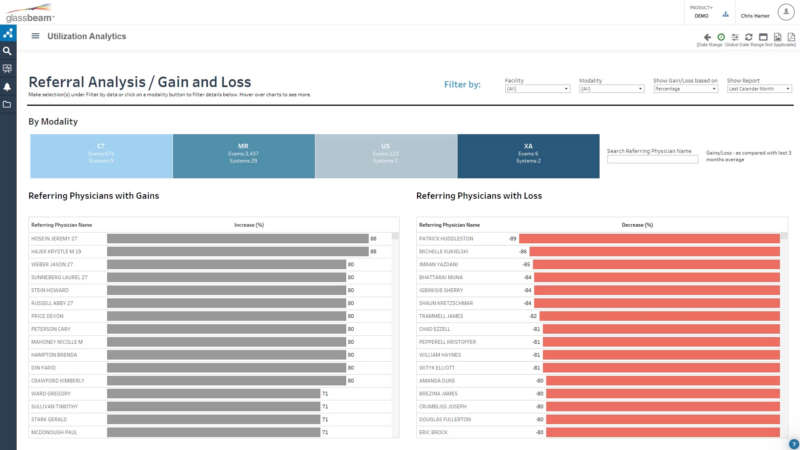
The Challenge of Schedule Gaps in a Medical Imaging Department
Overcoming Scheduling Gaps in Medical Imaging
Whether it’s managing patients and compliance regulations or ensuring the accuracy of diagnosis, radiology departments rely heavily on data to optimize business outcomes. Without being addressed, these challenges impact patient throughput and lead to massive scheduling gaps.
In this article, we’ll analyze common challenges for imaging departments and review viable solutions. With the right technology partners, medical imaging leaders can refine their scheduling and unlock new levels of operational efficiency.
Challenges for imaging departments
Radiology departments face numerous hurdles in the delivery of medical images. Technological advances have increased the demand for skills and equipment. Management challenges have created workflow bottlenecks. And demographic changes have led to systemic coverage gaps. Within this already challenging environment, there’s also been a renewed focus on early detection and predictive analytics to reduce the burden of chronic disease.
Data is the answer
Like many things in modern life, data is the biggest driver of change. With access to the right information, you can gain visibility into your business and optimize your workflows. From patient throughput and satisfaction rates to equipment management and profitability, leveraging data allows you to streamline all aspects of your business. When you access and integrate data sources, you can find and fill all existing and potential scheduling gaps.
Setting a schedule
Setting a schedule is the best way to support your patients and staff. You need to analyze current systems to find existing gaps, and implement new solutions to maximize your time and resources. The following challenges need to be overcome:
Scheduling referrals
Medical imaging is based on referrals, with patients typically coming through GPs, specialists, and hospitals. This makes it difficult to manage scheduling, especially when you have referrals coming from multiple third parties. To overcome this challenge, it’s important to combine real-time analytics with actionable metrics. For Example, an interactive dashboard may highlight schedule gaps through white spaces, and a weekly report may show you who accessed an MRI and CT scan.
Load balancing across sites
Medical imaging is a complex field that involves trained experts and specific technologies. Due to the specialized nature of the industry, many centers are run by large corporations. When a company operates many imaging centers, even a minor staff shortage can lead to scheduling challenges. Interactive software allows you to analyze data and balance appointments across multiple locations. Instead of dealing with delays and bottlenecks, this allows you to optimize patient throughput and limit scheduling gaps.
Equipment protocols and management
Medical imaging relies heavily on technology. There are several RAD tech modalities available, including MRI and CT scan equipment, ultrasound (U/S), fluoroscopy, and radiography (X-rays). These modalities all have different protocols and compliance standards. They also have distinct asset management and maintenance demands, which can change for imaging asset type. Without dedicated real-time software, staying on top of this equipment can be very difficult.
Realizing a schedule
Setting up a schedule for your medical imaging center is one thing, but it’s certainly not everything. To ensure patient safety, staff engagement, and business profitability, it’s vital to realize this schedule on a day-to-day basis. The following challenges are key:
Managing appointments
Operating a medical imaging center is about more than providing an MRI and CT scan — it’s about utilizing your assets efficiently. As the days and weeks tick over, you need to make sure that patients and staff are kept on schedule. Once again, this is not possible without real-time data visibility and analysis. Whether it’s reviewing patient timeliness, managing a staff shortage, or analyzing exam volumes, positive change relies on overcoming scheduling gaps.
Aligning slots and exams
It’s important to have complete visibility over your imaging assets and their utilization. With so many modalities available at any time, it’s vital to select the right appointment slot based on exam type. Medical examinations use vastly different imaging assets, and they also involve different staff members and time periods. Without an interactive and highly visible software platform, it’s impossible to avoid scheduling gaps and double bookings.
Creating consistent systems
Consistency is the key to predictive analytics, not to mention profitability. If you operate any kind of medical imaging center, it’s important to minimize variation for the sake of efficiency. Without accurate data and regular review, appointment slots can easily roll over and affect patient throughput. Dedicated software analytics allow you to view exam start and end times for each site and RAD tech operator, so you can build a consistent workflow and avoid scheduling gaps.
Benefits of medical imaging analytics
The medical industry relies heavily on data for predictive analytics. Specific information is used every day to make life-changing decisions and give patients the best possible care. Access to data also impacts business decisions, affecting everything from appointment times to equipment management and staff turnover.
When you have access to the right data at the right times, you can expect to:
- Enhance operational efficiencies
- Access real-time records and analytics
- Benefit from data visibility and integration
- Get and place more referrals more often
- Enjoy the benefits of operational consistency
- Improve asset management and maintenance
- Avoid scheduling gaps without compromising standards
In a case study by Glassbeam titled Enhancing Operational Efficiency with Glassbeam Analytics, TRA Medical Imaging achieved massive efficiency improvements, particularly in MR. By leveraging Glassbeam insights, TRA managed to optimize many aspects of patient scheduling, workflows, and staffing. According to Yahne from TRA, “Glassbeam empowers us to gain deeper insights into our operations. For Example, we can review our actual scan times compared to the scheduledtime slots. This helps us understand how efficient we are with our scheduling.”
Read the Case Study
The Glassbeam solution
At Glassbeam, we are your trusted data experts. We leverage data analytics for the medical imaging sector, delivering key insights to improve all aspects of operation. With access to accurate data on a real-time basis, you can get ahead of the curve and fill in your scheduling gaps. We offer a range of data solutions for the medical sector, including utilization analytics and service analytics.
Glassbeam Utilization Analytics helps you to manage medical assets. When you understand the utilization rates of specific assets, you can serve patients more effectively and place staff more accurately. Utilization analytics is a huge benefit for any business, especially when resources are limited.
Glassbeam Service Analytics helps you to avoid unplanned downtime. Regardless of why it happens, downtime results in fewer examination slots and lost income. If your equipment goes down or the right people aren’t available for whatever reason, you need to cover yourself through integrated service analytics.
Reach out to Glassbeam today to learn more about our medical imaging services. If you want more information, you can review our case studies right here. When you have the right data by your side, you can avoid scheduling gaps.
Explore the Possibilities
With more than 1 million exams examined each day by Glassbeam solutions, see how top organizations are transforming their log data into impactful insights.
Transform Your Healthcare Operations
See how to gain deeper, clearer insight from your machine data to elevate business intelligence and to improve your operational uptime, utilization, and efficiency.

